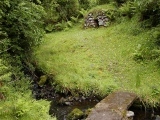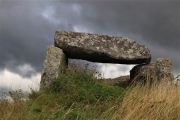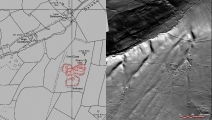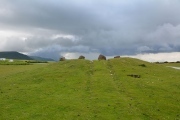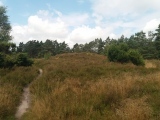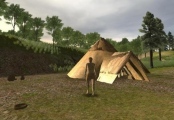Andy Burnham's Blog, page 164
August 6, 2021
Irish Sweathouses and the Great Forgetting
To celebrate 20 years of the Megalithic Portal, we'll be rerunning a selection of our news items from 20 years ago. Here's one from June 2001 highlighting an article by Anthony Weir which is still online. A fascinating article from Anthony Weir: Are Irish sweathouses a continuation of a prehistoric tradition of inhaling consciousness-altering smoke, recently overlaid with the prophylactic function of saunas ?
Cannabis is not likely to have been used in Ireland for a millennium at least, but a much more seriously-numinous means of widening the awareness is still to be found all over the island: Psilocybe lanceolata, or "magic mushrooms"....
Cannabis is not likely to have been used in Ireland for a millennium at least, but a much more seriously-numinous means of widening the awareness is still to be found all over the island: Psilocybe lanceolata, or "magic mushrooms"....
Published on August 06, 2021 10:16
Cefn Llanerchi
A video talk of recent investigations to try to find the original location of this now-fallen standing stone, see lower down our page for more. Also investigations into the nearby Lluest Aber Caethon ring cairn, the mysterious lost mound of Carn Ricet and updates on other upland survey work around the Elan valley in Powys. At this site are two standing stones, one fallen (4 metres long) and the other 2 metres long and leaning steeply. It's not far past a group of masts and aerials and is a recommended starting place to go in search of the nearby stone row.
Published on August 06, 2021 03:24
Cairn Na Mairg
The ruins of a broch with preserved sectors of outer walls and an exposed section of a mural gallery. On the bank of the River Thurso, about a kilometre south of Westerdale, Caithness.
Published on August 06, 2021 01:55
August 4, 2021
Luttra 15:1
There are two passage graves (gånggrift) next to each other here at this site in Sweden. This is the western one which sits on a mound some 14 metres by 7 metres. The seven orthostats and capstone make an impressive scene. The chamber is 7 metres long and 2.5 metres wide and is orientated in a NNE to SSW direction. The capstone is 3 metres by 2 metres and balances spectacularly on the orthostats.
Published on August 04, 2021 14:18
August 3, 2021
Ewe Close
Help wanted to investigate possible LIDAR discoveries on the ground, and here are a few examples that are known about. More details in the comments on our page, and discussion in the forum.. At this location are enclosed and unenclosed Romano-British period hut circles and a later Medieval farmstead. Scheduled Monument 1007589, excavated 1907-08
Published on August 03, 2021 08:39
Twyn-Y-Beddau
Twyn-Y-Beddau round barrow lies near the mountain road leading up from Hay-on-Wye towards the Black Mountains (Grid Ref. SO 24148 38612). Five separate burial sites have been found within this barrow. The stones on top are modern, to stop people driving over the barrow.
Published on August 03, 2021 04:14
August 2, 2021
Hügelgräberfeld Lohheide
This beautifully landscaped barrow cemetery now consists of 10 tumuli. Some were badly damaged or destroyed over the years by sand mining and the construction of the Eibia ammunition factory in the 1930s. Emergency excavations during this period have shown that the tumuli can be dated from 1500 to 1200 BC in the Bronze Age.
Published on August 02, 2021 06:06
Rhiwnant Prehistoric Ancient Settlement
A large enclosure with the stones from 3 hut circles set, on a slightly sloping site above the Rhiwnant stream, near Elan, Powys. Best viewed from above the site, higher up the mountain. A scheduled ancient monument and of national importance.
Published on August 02, 2021 05:56
Heracleion
Fragments of fruit baskets from the fourth century BC that have lain untouched since Thonis-Heracleion disappeared beneath the waves in the second century BC
. Thonis-Heracleion (the Egyptian and Greek names of the city) is a city lost between legend and reality. Before the foundation of Alexandria in 331 BC, the city knew glorious times as the obligatory port of entry to Egypt for all ships coming from the Greek world. It had also a religious importance because of the temple of Amun, which played an important role in rites associated with dynasty continuity. The city was founded probably around the 8th century BC, underwent diverse natural catastrophes, and finally sunk entirely into the depths of the Mediterranean in the 8th century AD.
. Thonis-Heracleion (the Egyptian and Greek names of the city) is a city lost between legend and reality. Before the foundation of Alexandria in 331 BC, the city knew glorious times as the obligatory port of entry to Egypt for all ships coming from the Greek world. It had also a religious importance because of the temple of Amun, which played an important role in rites associated with dynasty continuity. The city was founded probably around the 8th century BC, underwent diverse natural catastrophes, and finally sunk entirely into the depths of the Mediterranean in the 8th century AD.
Published on August 02, 2021 04:42
August 1, 2021
Doggerland
A free virtual tour of the new exhibition opening now in the Rijksmuseum van Oudheden in Holland - more details in the comment on our page. At the height of the last Ice Age, Doggerland was dry and stretched from the present east coast of Britain and the present coasts of The Netherlands, Denmark and North Germany. Thus, the so-called land-bridge, was a place where people settled as the ice-sheets wasted and northwestern Europe became habitable once more. But, as the ice-sheets retreated further and sea levels rose, the North Sea encroached on the land, eventually separating the British Peninsula from the mainland.
Published on August 01, 2021 06:35

